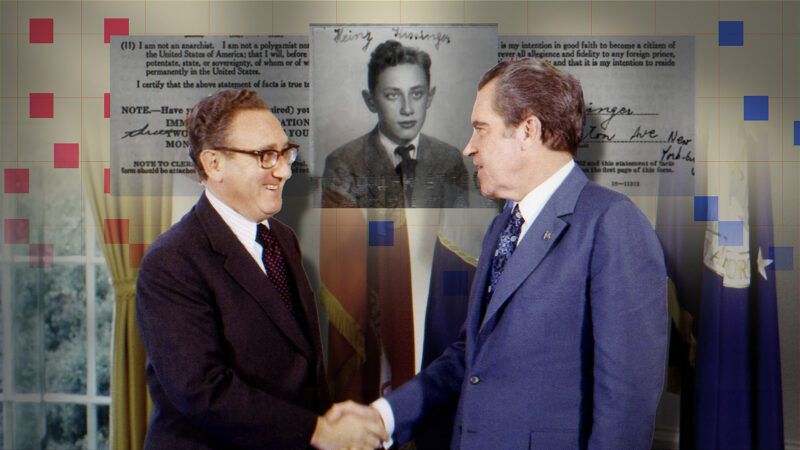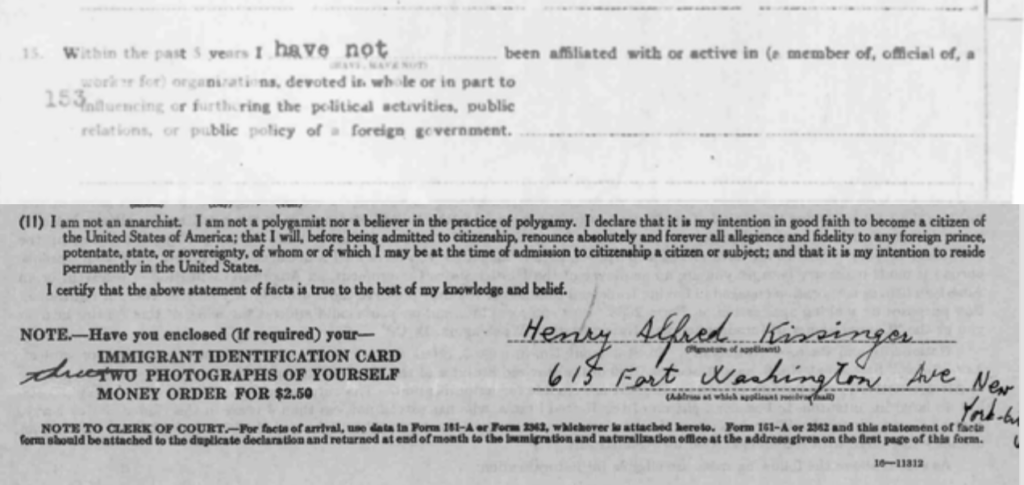How Did Kissinger Become an American Citizen?
Reason has obtained an exclusive copy of Henry Kissinger's immigration files from the 1940s.

Before he became America's most controversial secretary of state, Henry Kissinger was a refugee boy named Heinz from Fürth, Germany. He had the pouty look of a teenager, with a hint of impish curiosity. His birth certificate bore the swastika emblem of the Nazi German state, but his visa application said that he was "of the Hebrew race," a very good reason to leave Germany at the time.
Six months after Kissinger's parents filed that application with the U.S. Consulate in Stuttgart, and two months after the family arrived in New York, the Nazi government invalidated all German Jews' passports. Kissinger had just escaped a genocide.
Reason has obtained an exclusive copy of Kissinger's immigration file under the Freedom of Information Act (FOIA). It includes both his original entry documents from the 1930s and his naturalization forms from the 1940s. The papers provide intimate snapshots of Kissinger's early life, when he was first starting to realize the power and danger of politics, but before he took that power for himself.
If Kissinger was an impish boy when he applied for a visa, he was a world-weary man by the time he gained U.S. citizenship. Photos attached to different forms over the years show Kissinger's face growing more mature, his gaze more alert, his teenage impishness more muted.

Those images were almost lost forever. Shortly after Kissinger's death last year, I sent FOIA requests to several federal agencies for his files. (The Privacy Act prevents the government from releasing data on living citizens, but anyone can ask for records on the dead.) The U.S. Citizenship and Immigration Service said that they couldn't find Kissinger's file. When I complained in a (now-deleted) tweet, the FOIA office abruptly claimed that his file turned up.
The basic details in the files are well-known to Kissinger's biographers. He was drafted into the U.S. Army in 1943 and became a naturalized American citizen during his basic training at Camp Croft in South Carolina.
Kissinger's talents were quickly recognized, and the Army promoted him to be a counterintelligence officer in charge of denazifying German territory. It set him up well for a meteoric rise through the government during the Cold War.
During his Army service, Kissinger stopped going by the name "Heinz" and started going by "Henry," a fact that was noted in his naturalization application. He later said that Army service was an "Americanization process."
That process was a lot simpler in the 1940s. To get a visa, Kissinger's parents had to provide some basic biographical information and provide the address of a cousin in New York.

To become a citizen, Kissinger had to list any travel outside the country and swear that he was not an "anarchist," a "polygamist," a foreign agent, or otherwise loyal to any "foreign prince, potentate, state or sovereignty."

Some of the fields on the forms are jarringly out of date today. The U.S. forms offered five racial categories to choose from: "White," "Negro," "Chinese," "Japanese," and "Other." And, of course, today's Germany would not categorize its citizens by whether they belong to the "Hebrew race."

Kissinger's entire immigration file—including his visa application, his alien identification card, his Army background check, and his citizenship papers—are only 50 pages in total. It took five years after his arrival to become a U.S. citizen. Compare the thousands of pages of paperwork and decades of waiting it takes today.
Ironically, Kissinger became an advocate of shutting the door on others. He was infamously caught on tape telling then-President Richard Nixon in 1973 that "the emigration of Jews from the Soviet Union is not an objective of American foreign policy, and if they put Jews into gas chambers in the Soviet Union, it is not an American concern."
In an October 2023 interview with a German journalist, Kissinger said that "it was a grave mistake to let in so many people of totally different culture and religion and concepts, because it creates a pressure group inside each country that does that." He died the following month.
It is hard to imagine that a young Heinz Kissinger knew where he would end up in a few decades: telling the most powerful man in the world not to care about Jewish refugees. Or that he knew his last public act would be railing against diversity on German television.
But that's America. Anyone can reinvent themselves however they'd like.
Show Comments (40)